
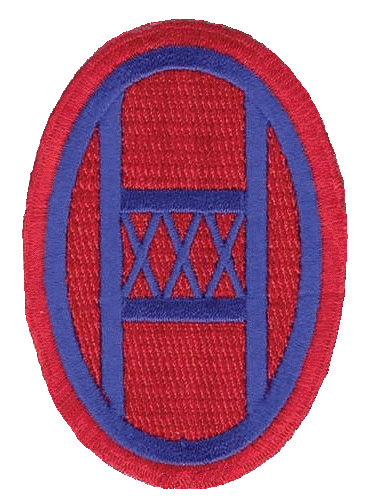

3rd Battalion - K Company
30th Infantry Division



Steve Spicer's Maps of the 117th Regiment in France, Belgium, and Germany
Steve Spicer created a "Google Map" showing the movements of the 117th Regiment in France, Belgium, and Germany.
Click here to view his map: 117th Regiment in France, Belgium, and Germany
Screen shots from the map are shown below
Map Showing Overview of Movements of the 117th Regiment in Europe
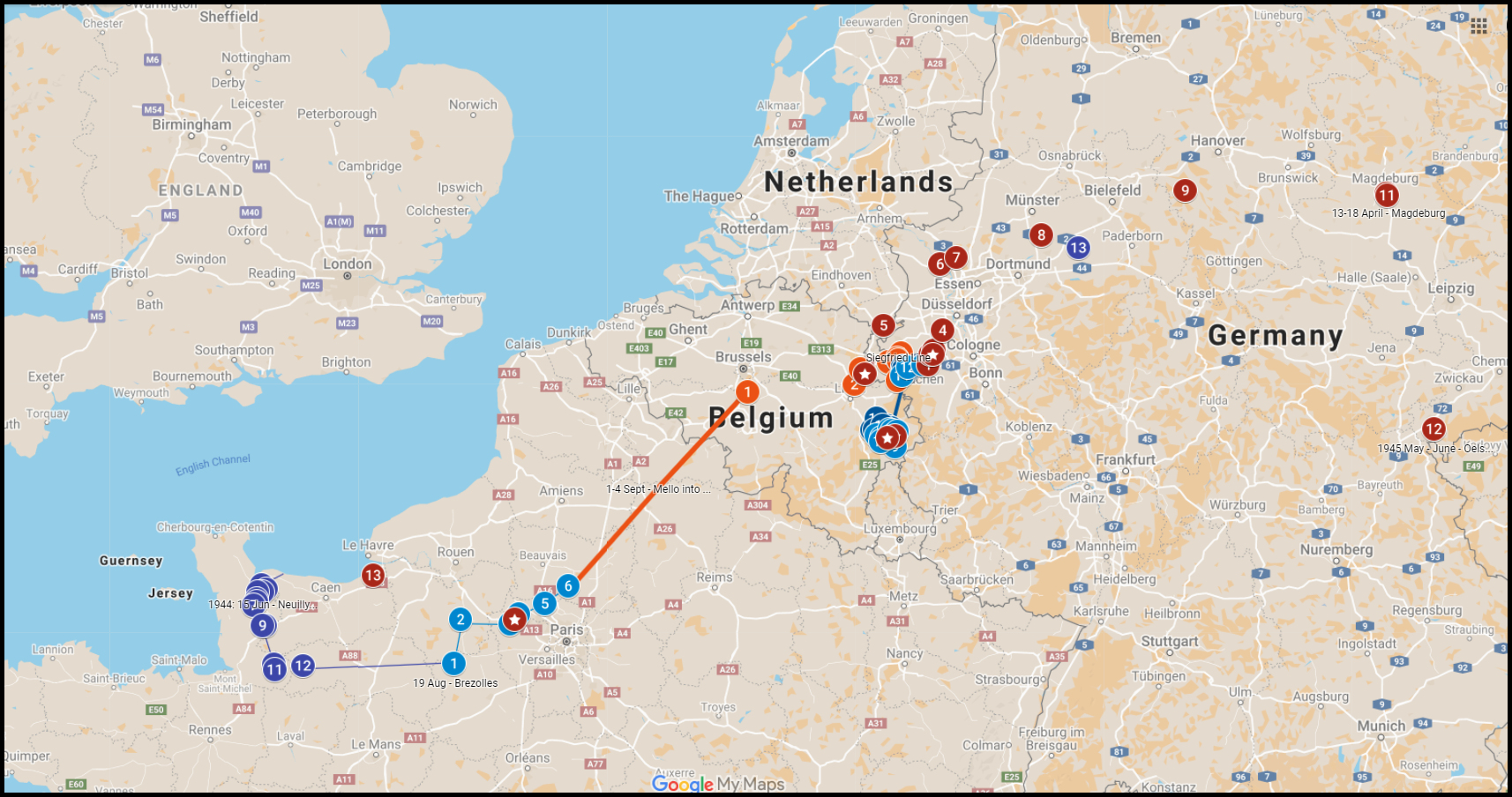
Detail Maps
Normandy Landing to Saint-Clair-de-Halouze, France
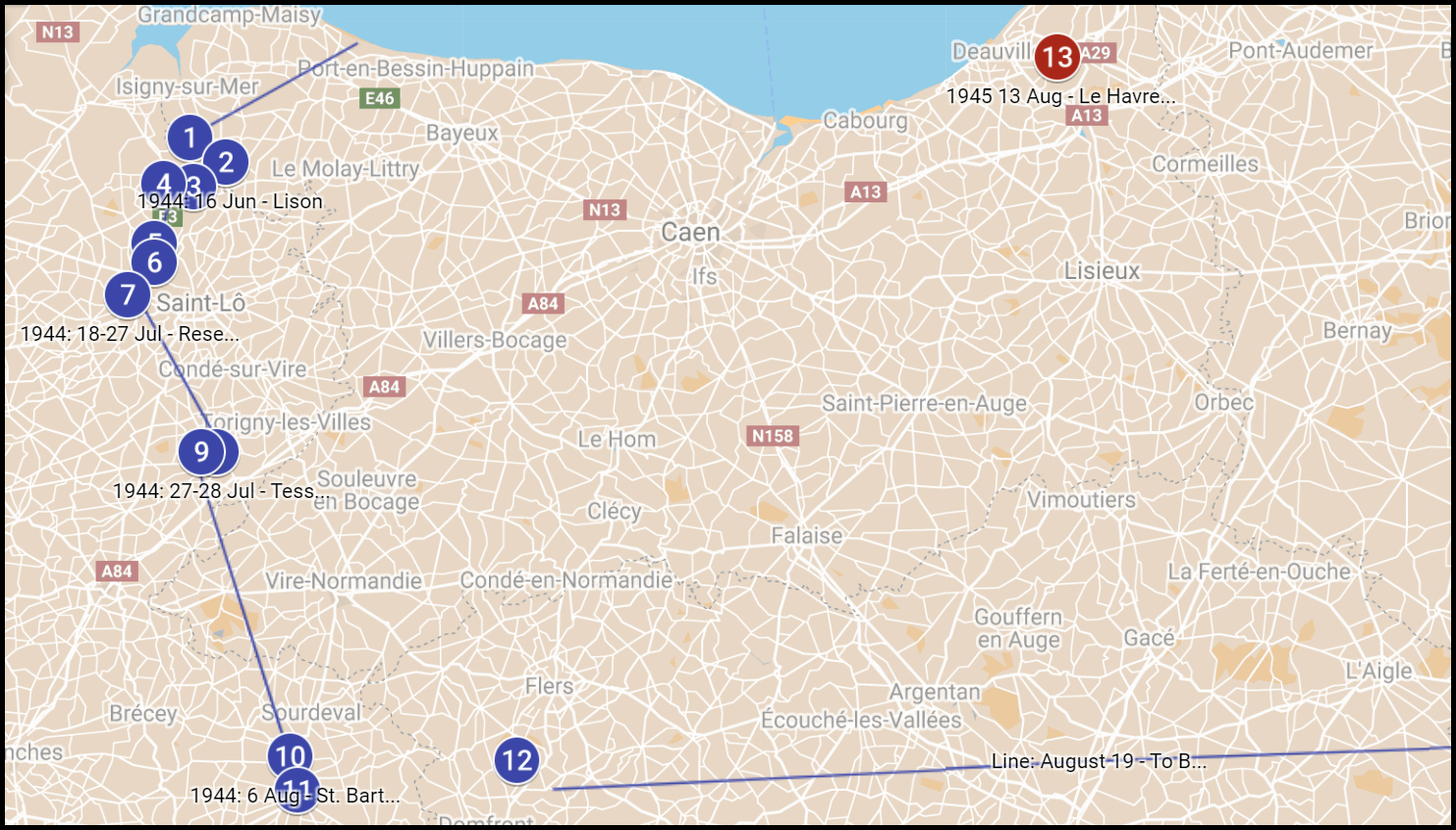
|
|
June 15 | Neuilly-la-Forêt,
France
Assembly following landing on the beach at Normandy |
|
|
June 16 | Lison, France Assembly to take up a defensive line along the east bank of the Vire River from Aire [Airel] north to Neuilly la Foret. - approximately 3 miles. |
|
|
July 7 | Crossing the Vire
River, France 117th crosses the Vire River at Airel. |
|
|
July 8-9 | Saint-Jean-de-Daye,
France, Captured All three regiments of the 30th Infantry Division attack south and west of the Vire towards Hauts-Vents. |
|
|
July 11 | Capture of Hauts Vents,
France
General Hodges mentions in his diary that on the 13th of July: “XIX
Corps: the 30th Div’s 117th Inf advanced to a point 600 years SW of
Vents [Hauts-Vents];…” |
|
|
July 14 | Le Mesnil-Durand [House of Durand],
France
July 14 advance to take up high ground west of ST-LO. (Mesnil Durand
is mentioned several times in the AAR, and in the ST-LO book, but is
not found on current maps. (“Mesnil” is derived from the Latin
mansionile, meaning a small mansion or dwelling. So, we can assume
that in the AAR, the writer is saying "the house of Durand." |
|
|
July 18-27 | Reserve and Accidental Bombings
For six days the 117th went into Division Reserve. |
|
|
July 27-28 | Tessy-sur-Vire, France Ordered south 8 miles to capture Tessy-sur-Vire. which was accomplished on July 31 by a combined attack of the 2nd and 3rd Battalions of the 117th. Bitterly contested by the enemy, more than 200 casualties were suffered by the Regiment. It was the most difficult engagement in which the regiment had participated in to that date. |
|
|
August 1-3 | La Poemelière, France Broke the enemy line at Le Mesnil Opac, where it fought a fierce engagement for three days, and achieved its objective near Poemeliere on the 2nd, dug in, and the following day was placed in Division Reserve. |
|
|
August 6 | St. Barthélmy, France By August 6, the entire 30th Division was on the road heading towards Mortain to relieve positions previously held by the 1st Infantry Division. The 117th Regiment settled into position around St. Barthélmy. While the 119th was retained as strategic reserve along the ridge road west, while the 2nd Battalion of the 120th moved onto Hill 314, the 1st occupied Hill 285. By nightfall all were where they were supposed to be, albeit under strength by about 1,000 men from normal strength of 9,000. (Collins, pgs 137-8) |
|
|
August 7-13 | St. Barthélmy & Mortain,
France
The 117th faced the enemy attack in force, in a Hitler ordered drive
to the sea meant to split Allied forces. The spearhead of this blow
was directed at the 117th Infantry. The 2nd Battalion of the
Regiment, less “G” Company, was attached to the 120th Infantry
during this period. The remainder of the 117th Infantry was
practically isolated on the ridge, and the enemy succeeded in
breaking through the forward defenses of the 1st Battalion. |
|
|
August 8-15 | Saint-Clair-de-Halouze,
France Reinforced by the 12th Infantry Regiment, the 117th re-occupied St. Barthélmy. By the 15th had gained objective near St. Claire D’Halouse, approximately 12 miles to the east, where it set up a defensive line for three days |
August 19 to 30, 1944

|
|
August 19 | Brezolles, France Following the Battle of Mortain, the 117th travelled 130 miles east to an assembly area at Brezolles. |
|
|
August 24 | Évreux, France, Liberated From 20 August 1944 to 24 August 1944, the 117th Infantry, less the 3rd Battalion, was in Division Reserve. However, the 30th Infantry Division was advancing northward toward Évreux, France, and the 3rd Battalion of the 117th Infantry was protecting the left flank of the Division. Little opposition was encountered, and on 24 August 1944, the 3rd Battalion of the 117th Infantry liberated the town of Évreux, France.” |
|
|
August 25-26 | Advance to Mantes-la-Jolie, France
“On 25 August 1944, the Regiment made and uncontested advance to the
vicinity of La Chapelle, France. The next day it moved to an
Assembly Area at Mantes, Gassicourt, France. It was a major
assembly point for the U.S. Army to make the first bridgehead across
the Seine. |
|
|
August 27 | Lainville-en-Vexin, France On the 27th the 117th crossed the Seine and drove towards Lainville |
|
|
August 30 | Vallangoujard, France The 117th entered Vallangoujard. |
|
|
August 31 | Mello, France The 117th entered Melo. |
September 1944 to October 1944
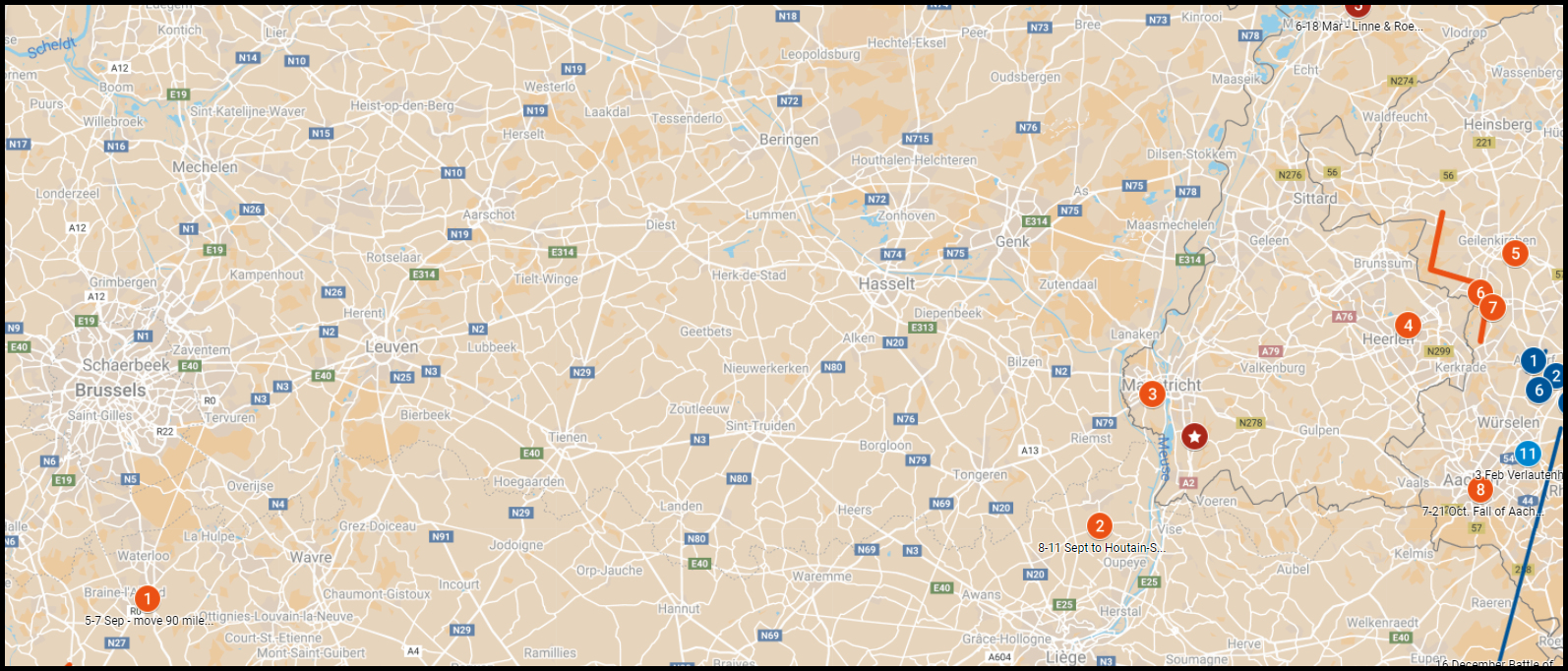
|
|
September 5-7 | Lauminais and Ceroux-Moustie, Belgium The regiment marched to Lauminais, Belgium, and then motored ninety miles more to an assembly near Ceroux-Moustie, Belgium. |
|
|
September 8-11 | Houtain-Saint-Siméon, Belgium Gas was short so the 117th hiked for three days winding up at Houtain-St. Simeon on the 11th. |
|
|
September 12-18 | Across the Meuse and Albert Canal to
Maastricht, Netherlands On 12 September, the 117th crossed the Albert Canal and Meuse River in force near Hermalle Sous, Belgium, and drove north through Vise. “A” Company enters Holland near St. Geertrudi, becoming the first American troops to enter Dutch frontiers. By nightfall obtained its objective near Elkelrade, Holland. The 117th gained objectives near Cadier-en-Keer, Holland, and later liberated Maastricht by the 18th. |
|
|
September 18 | Heerlen towards Nieuwenhagen, Netherlands The 117th attacked northeast through Heerlen advancing to the vicinity of Nieuwenhagen. |
|
|
October 2 | Geilenkirchen, Netherlands “At the day’s end, leading elements of the 30th Division – represented by the 117 and 119th Infantry had progressed to a point 600 yards east of the main railroad line running south from Geilenkirchen. Opposition from the pillboxes was consistently heavy throughout the day and the artillery and mortar fire were strong.” (Hodges, Normandy to Victory, page 141.) |
|
|
October 3 | Marienberg-Palenberg Bridge, Germany The Marienberg-Palenberg bridge was crossed by the 3rd Battalion on October 3. (from an Interview with Lt. Col. McDowell) |
|
|
October 3-4 | Übach-Palenberg, Germany The 3rd Battalion crossed the Marienberg-Palenberg Bridge of its objective, Ubach. Having entered Germany, the 3rd Battalion was in a house-to-house battle for Ubach, the Germans counter-attacking on the 4th. |
|
|
October 7-21 | Fall of Aachen, Germany The 117th participated in the capture of the City of Aachen, Germany, making it the first city in Germany to fall. While the 30th Infantry Division’s 119th Regiment, along with units from the 20th and 99th Infantry Division took the attack south to meet the German counter-attack begun on October 11th, the 120th and 117th Regiments pushed the German line to the southeast through Alsdorf. The attack was successful with elements of the 1st Infantry Division, but cost the XIX Corps over 400 dead and 2,000 wounded, with 72% of those from the 30th Division. The bitter house-to-house for fighting finally won Aachen on October 21, costing both sides dearly, the Americans suffering over 7,000 casualties, 3,000 of those from the 30th Division since October 2. |
November 1944 - December 1944 - Battle of the Bulge

|
|
November 1-15 |
Defense
along a line running from Schaufenberg, Alsdorf, to Kellersberg,
Germany From Nov 1 to 15 the 117th Regiment maintained an active defense along a line running from Schaufenberg, Alsdorf, to Kol Kellersberg [Kellersberg] Germany. Deep penetrations by reconnaissance elements were made repeatedly into enemy territory. |
|
|
November 16-17 | Mariadorf, Germany In a perfectly conducted attack, the regiment attacked Mariadorf, Germany. It encountered dense enemy mining and artillery fire causing a number of casualties. The attack resumed on the 17th and the 1st Battalion cleaned out the remainder of the town and progressed 700 yards (about a third of a mile) beyond the Aachen-Cologne Highway against stubborn resistance. 332 prisoners were taken in the two days of fighting. |
|
|
November 18 | Warden, Germany 1st Battalion attacked the town of Warden, Germany, the attack initially thwarted by heavy enemy artillery which saw Company “B” alone losing more than seventy men in an afternoon renewal of the attack. Company “F” responded with a coordinated attack on the town against the enemy in concrete emplacements, houses as strong points, supported by at least four direct-fire assault guns. Nevertheless, the key town was seized in bitter house-to-house fighting. Another 209 prisoners were taken in addition to tons of ammunition and two self-propelled assault guns. |
|
|
November 19 | Kinzweiler
& St. Joris, Germany 2nd Battalion passed through the 1st Battalion and attacked south in the direction of Kinzweiler, Germany. |
|
|
November 19 | St. Joris Simultaneously with the attack on Kinzweiler, the 3rd Battalion attacked St. Joris. Both objectives were taken within thirty minutes with light casualties. 223 prisoners were taken. |
|
|
November 20 - December 16 | Rest & Training During this period the 117th Infantry constituted Corps Reserve near Mariadorf. The battalions alternated in going back to a Rest Camp at Kerkrade for well-earned periods of relaxation. |
|
|
December 16 | Battle of the Bulge
Begins -
The 117th
Blocks Roads The 117th was in Rest Status for nearly a month at Mariadorf until December 16 when it rushed about 25 miles south to take up defensive positions around the southeast edge of Malmedy. A few miles northwest of Malmédy, on the road to Francorchamps, was the location of Depot Number 3, a huge allied fuel dump that contained 997,730 gallons of gasoline - more than enough to get the attacking German tanks all the way to Antwerp. It was only being guarded by a handful of poorly-equipped Belgian soldiers. The 117th Infantry Regiment immediately got to work setting up roadblocks and preparing to meet the SS; while 3rd Battalion of the 117th set up those roadblocks, 1st Battalion of the 117th moved past the fuel dump in Francorchamps and disembarked a few miles north of Stavelot, roughly five miles southwest of Malmédy." |
|
|
December 18-19 | Malmedy, Belgium
The 120th Infantry Regiment (30th Infantry Division) proceeded to
Malmedy. “Spa, Malmedy and Stavelot form a rough triangle of roads
suitable for an armored force to use in a winter offensive. Stoumont
lies further west along the road running through Malmedy and
Stavelot. Von Rundstedt planned to use these roads for the main
German thrust to Liege where the Allies had huge stores of fuel,
ammo and essential supplies. Thus the Germans would split the Allied
forces and push on to recapture the port of Antwerp. |
|
|
December 18-19 | Stoumont, Belgium "The 117th Regiment encountered the enemy first near Stoumont in route to their assignment of Stavelot. The 120th proceeded to Malmedy while the 119th took up positions near Spa, where First Army Headquarters was being hastily dismantled and moved to the rear." |
|
|
December 18-19 | Stavelot, Belgium The 1st & 2nd Battalions advanced toward Stavelot. |
|
|
December 8-19 | Spa, Belgium The 119th Infantry Regiment (30th Infantry Division) took up positions near Spa, where the First Army Headquarters was being hastily dismantled and moved to the rear. |
|
|
December 19-26 |
La Gleize, Belgium The 3rd Battalion was directed to recapture the town of La Gleize, Belgium. The intense fighting in this triangle with counter-attacks by the enemy lasting until the 26th. |
|
|
December 26 | Americans Win
Battle of the Bulge By 26 December 1944, the Nazi bulge into Belgium was firmly held and the 117th Infantry had practically wiped out an entire German SS Regiment. Not many prisoners were taken but enemy dead filled the forests, the fields, and the river. In the Regimental Sector alone, twenty-two tanks were knocked out, twelve half tracks, thirty-two trucks, and seven guns of various calibers were destroyed, in nine days fighting. |
January 1945 - St. Vith - Repulsing the Germans

|
|
January 6-7 | Trois-Ponts (117th) On January 1 the 30th Division front line extended from a point slightly east of Malmedy to a short distance west of Stavelot. Extremely deep snows, roads covered by ice and flanked by 6-foot snow drifts. The high ground was occupied by the Germans. It was necessary to cross the Amblève River between Trois-Ponts and Stavelot, Belgium. Undercover of dark foot bridges were constructed across the river and Company G, 117th Infantry crossed the river under cover of darkness, and by 0700 the entire regiment was over the river and had taken up positions in the corner enclosed on the north by the Amblève and on the east by Salm River. The attacks next came southeast to Wanne. Objective villages lay to the southeast, Wanne, Aisômont, Wanneranval, Bouyin, Le Bairsoû and Spineux. In this two day period, the enemy had been cleared out of the Salm-Amblève pocket and the first step had been taken in the rapid, relentless drive of the 30th to the vicinity of St. Vith. |
|
|
January 6-7 | Objective: Wanne The 117th takes Wanne. |
|
|
January 13 | 117th, 119th and 120th Regiments Attack 119th Regiment attacked south in what was to become a very costly offensive. (The offensive to St. Vith by the 30th Division was two pronged, east (119th and 120th) and west (117th) and it was the eastern prong that suffered the most; the total number for the 120th for the 13, 14, and 15th of January amounted to 450 killed, wounded and missing.) |
|
|
January 13 | Hédomont, Belgium The 119th was instructed to take Hédomont that night and under cover of heavy artillery barrage it took the town after almost five hours of steady fighting in the early hours of the 14th the 3rd Battalion was in possession of the city. |
|
|
January 14 | Ligneuville,
Belgium The 2nd Battalion of the 117th attacked south with Ligneuville as the objective. “Moving south toward Ligneuville from Houyier, the 2nd Battalion, 117th Infantry, avoided being observed to any great degree by advancing along the west side of the Malmedy-Ligneuville road. The trees were thick, the knee deep snow drifts were higher by 3 or 4 inches more of snow that had fallen during the night and communication was difficult. At 1200 hours, 14 January, the battalion was in the outskirts of Ligneuville. The were met by scattered units that were displaced in the stone buildings of the city. Fire fights continued throughout the afternoon in the city of Ligneuville, but by 1600 the enemy had been driven out. Moving through the city quickly, on the St. Vith road, Company “E” approached the bridge spanning the Abeleve River. The bridge, at 806987, had been prepared for demolition by the Germans, but the Company “E” commander, Capt. George H. Sibbald, cut the wires and led his troops across. With all three companies in the city, the 2nd Battalion, 117th Infantry, consolidated their positions and were not taken unaware by the German counter attack launched at 2000 hours. Estimated at a battalion of infantry and supported by six tanks, the enemy attempted to regain Ligneuville. They were unsuccessful, however, and were forced to withdraw.” |
|
|
January 15 | Thirimont (119th &
120th) Thirimont falls to the 120th Infantry Regiment of the 30th Infantry Division after several days of very intense fighting. |
|
|
January 16 | Dillburg (117th) The 117th attacked south towards Dillburg, locality northeast of Recht. Roadblocks and weather delayed successful advance. |
|
|
January 19-20 | Recht / Feckelsborn
(117th & 120th) The 117th on the right of the 120th prepared to attack Recht and in a very short time the enemy was cleared thanks to the heavy artillery barrage that preceded the attack. Eachelsborn [Feckelsborn] was the next objective. Objectives for the 30th Division were accomplished and they could almost see St. Vith. The enemy began to retreat to St. Vith and then on the 21st large groups of Germans began to evacuate the city to the south. |
|
|
January 21 | Rodt & Hinderhausen The 30th Infantry Division had captured Rodt and Hinderhausen northwest of St. Vith on high, dominating ground and the 7th Armored could attack the town proper. Losses were heavy in the 30th Division in the 10 day period from the 13th to the 23rd: 1,151 officers and men killed, wounded or missing plus 707 officers and men listed as non-battle casualties. |
|
|
January 26 | Grand-Halleux The 117th was relieved by a regiment from the 17th Airborne and moved to rest at Grand-Halleux. |
|
|
February 3 | Verlautenheide The 1st Battalion of the117th went to Verlautenheide, Germany, and then to Warden, Germany to train for crossing the Roer which was originally planned for the 10th, but had to be postponed when the Germans flooded the valley. The Division designated the 119th and 120th to be assault troops while the 117th was designated reserve initially. |
|
|
February 3-23 | Warden The 1st Battalion, 117th trains to cross the Roer. The crossing had originally been scheduled for the 10th, but the Germans blew dams and flooded the valley causing a postponement until the 23rd. |
|
|
|
Crossing the Roer The 119th and the 120th Infantry established a bridgehead across the Roer and 117th, initially in reserve, was committed through the forward units of the Division at 4:30 P.M. February 24th. The First Battalion remained in Regimental reserve, and in late afternoon, moved to the 119th crossing site near Schophoven. |
23 Feb - Mar 1945 to the Rhine
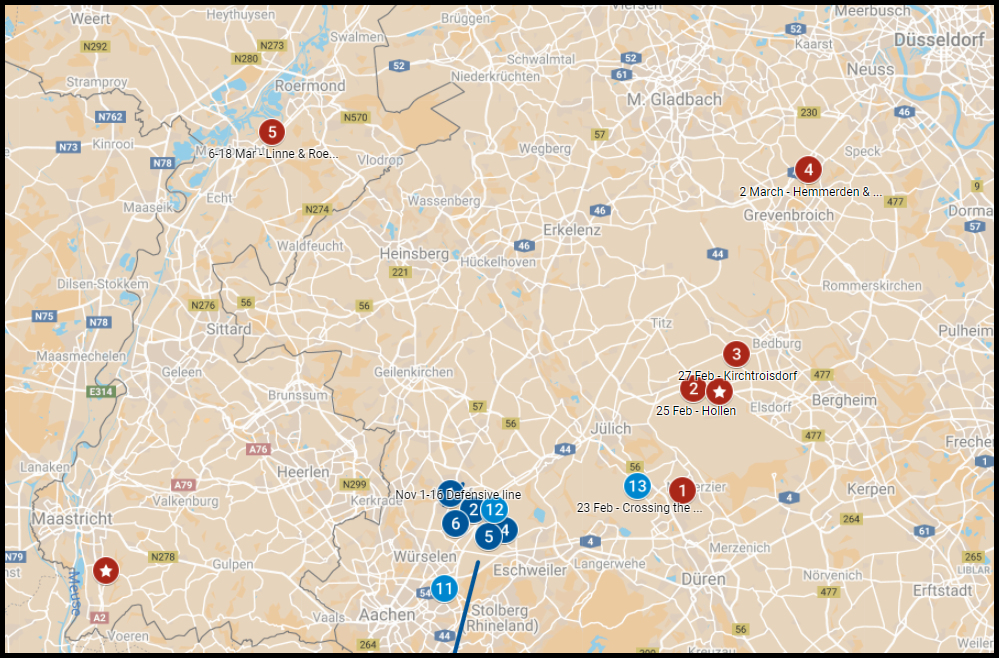
|
|
February 23 | Crossed the Roer
|
|
|
February 25 | Hollen, Germany Hollen was captured on the 25th by Company “G” of the 119th in an action that involved not only the 119th, but also the 120th. Exactly where the 117th was at this point is not completely known but it is evident from the citation for a second Oak Leaf cluster given to First Lieutenant Cyril B. Spicer, jr., that it provided support in this attack. |
|
|
February 27 | Kirchtroisdorf On February 27, elements of the 83rd Infantry Division and the 2nd Armored Division passed through the 30th Infantry Division to exploit the Roer breakthrough. The First Battalion stayed in Kirchtroisdorf several days. |
|
|
March 2 | Hemmerden & Kapellen On March 2, word was received that the Germans had penetrated the right flank of the 83rd Infantry Division across the Erft Canal. The 117th was to move up and get the situation under control. The First Battalion en-trucked at 2:00 P.M. and sped north 14 miles, de-trucked and worked their way forward into Hemmerden. They then moved on and recaptured the town of Kapellen, situated on the Erft Canal with Company "B" leading the Battalion attack. |
|
|
March 6-18 | Linne & Roermond 1st Battalion began a motor movement to Linne, Holland then to a point several miles south to Roermond for rest and also for training to assault the Rhine River. |

The 117th boarded the ship Marine Wolf for one of its 52 shuttle operations between Le Havre and Southampton, from which they made the almost five-day trip aboard the Queen Mary on August 17th for New York, a sailing with 14,776 troops. Having been designated to the Pacific, the surrender of the Japanese on the 14th made this moot. The 117th was deactivated at the end of November at Fort Jackson, South Carolina.
|
|
March 24 | Wallach, Germany & Across the Rhine The 30th Division commander had decided to simultaneously engage all three regiments for the crossing. The 119th began crossing in the north, just southeast of Buderich. The primary thrust in the center was provided by the 117th Infantry Division at the village of Wallach with the 120th attacking two miles to the southeast near a big bend in the river just northeast of Rheinberg. Each regiment used one battalion in the assault. Each assault battalion was organized into four waves with two minute intervals between waves. Each battalion was equipped with 54 storm boats carrying seven men and a two-man crew each, and 30 double assault boats capable of transporting 14 men and a three-man crew. |
|
|
March 25-26 | Hunxe, Germany After Action Report Interview with Major Julius W. Singleton, S-3, 117th Infantry at Waldeslust, Germany on the 28th of March. “We moved the regiment into assembly area near Wallach on the evening of 23 March 1945. The 1st Battalion made the initial crossing, taking Ork with Companies A and B abreast. 150 prisoners were captured there. The 2nd Battalion went through Ork and took objective Folly…” Katie, Ginny, Sue, and on the 25th took Anne. Company B went on in and captured the town of Hunxe. At 0200 26 March the 1st and 2nd jumped off for the next objective Sally. (More objectives taken but using objective names not towns.) |
|
|
March 31 - April 1 | Drensteinfurt, Germany On March 31, 1945, the 117th Infantry Regiment captured the Lippe Canal, then motored 55 miles to Brensteinfurt, Germany [Drensteinfurt]. Here they encountered a mass German surrender with German soldiers, hands up and running towards POW cages in the rear. Here they met the first of the streams of allied prisoners, thin as skeletons, liberated from German prison camps along with laborers from Poland, Czechoslovakia, Russia, and France. |
|
|
April 7 | Hamelin, Germany At 06:00 on April 7th, 1945 the 117th Infantry Regiment attacked and took the town of Hamlin, Germany. Hamlin, Germany [Hamelin] is famous for the Brothers Grimm story of the "Pied Piper of Hamlin" a children’s’ fairy tale. Here the Regiment captured hundreds of German soldiers as prisoners of war. |
|
|
April 13-18 | Magdeburg, Germany
"In early April of 1945, the Thirtieth Infantry Division of the US
Army National Guard advanced toward the city of Magdeburg, Germany.
Under the command of Major General Leland S. Hobbs, their orders
were to liberate the citizens of Magdeburg from the tyranny of
Nazism that held sway there under Adolf Hitler, who had commanded
his generals to continue to fight a war that was already lost. On
their way to Magdeburg, the Thirtieth Infantry Division sacked enemy
pockets and took the nearby towns of Hamelin on April 7 and
Braunschwieg on April 12. |
|
|
April 25 | Magdeburg, Germany "On April 25th, 1945 Lt. Gen. Kurt von Dittmar, German official army news commentator, together with Major Pluskat, Dittmar's son and two orderlies crossed the Eble River. They crossed at Magdeburg in the zone of the 117th's Third Battalion. Dittmar, the German General Staff radio spokesman, crossed in a boat under a white flag. He had come, he said, to arrange aid for German wounded on the east bank of the Elbe. It was then discovered he commanded no troops and traveled to the west without the knowledge of the German commander in that sector. Dittmar was then offered to surrender but he refused. On his way back to re-cross the river he changed his mind and surrendered along with his son and Major Pluskat, an artillery officer." |
|
|
May - June | Oelsnitz, Germany Conflicting spellings of towns and dates make the final months in Germany for the 30th Division and the 117th Infantry Regiment difficult to determine. Nevertheless, it seems that the 117th waited several weeks in Magdeburg for the Russians to link up and for the British to take command there. In late May, following Germany’s surrender, the Regiment moved to Oelsnitz near the Czech border some 150 miles to the south, while the 119th moved to around Hirschberg and the 120th to an area around Paulen, where they remained for some weeks. |
|
|
August 13 | Le Havre: to Home The 117th boarded the ship "Marine Wolf" for one of its 52 shuttle operations between Le Havre and Southampton. From Southampton, they made the five-day trip aboard the Queen Mary on August 17th for New York, sailing with 14,776 troops. Having been designated to the Pacific, the surrender of the Japanese on the 14th made this moot. The 117th was deactivated at the end of November at Fort Jackson, South Carolina. |
Additional Pages (Click Below)
© Copyrighted 2007 by Darrel R Hagberg. All rights reserved.
Moline, Illinois U.S.A.
February 24, 2024
Contact darrelrhagberg@gmail.com for more information